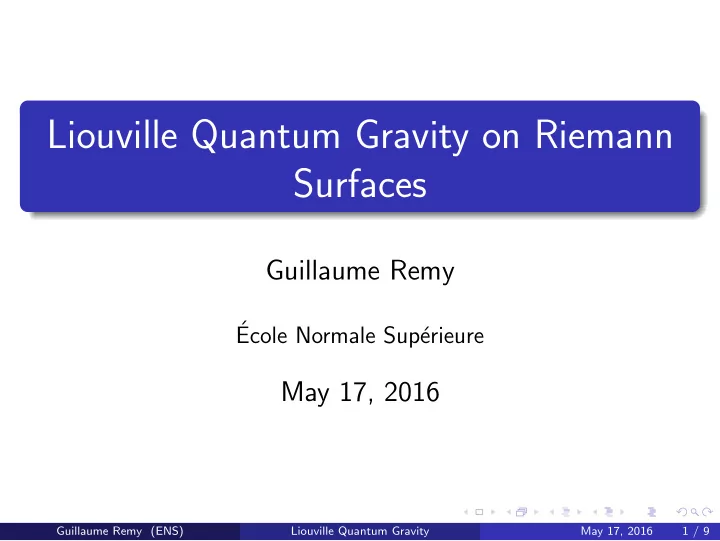

Liouville Quantum Gravity on Riemann Surfaces Guillaume Remy ´ Ecole Normale Sup´ erieure May 17, 2016 Guillaume Remy (ENS) Liouville Quantum Gravity May 17, 2016 1 / 9
Field Theory: a general framework Quantum Field Theory: a general framework in physics Goal: compute correlations of fields: � � i ∈ I φ i ( z i ) � Conformal Field Theory: conformal invariance in 2D Continuum limit of the Ising model Fields: spin operator Liouville Quantum Gravity: Polyakov, ”Quantum Geometry of Bosonic Strings” Guillaume Remy (ENS) Liouville Quantum Gravity May 17, 2016 2 / 9
Brownian motion seen as a path integral Space of paths: Σ = { σ : [0 , 1] → R , σ (0) = 0 } � 1 Action functional: S BM ( σ ) = 1 0 | σ ′ ( r ) | 2 dr 2 E [ F (( B s ) 0 ≤ s ≤ 1 )] = 1 � D σ F ( σ ) e − S BM ( σ ) Z Σ D σ : formal uniform measure on Σ Classical Theory / Quantum Theory Minimum of S BM → straight line = classical solution Path integral → Brownian motion = quantum correction Guillaume Remy (ENS) Liouville Quantum Gravity May 17, 2016 3 / 9
Some definitions Let ( M , g ) be a Riemann surface with a metric g . Metric tensor g : M → S + 2 ( R ) � b � g ij ( z ( t )) dz i dz j Length of a curve z = z i ( t ): dt dt a dt det g ( x ) dx 2 = � � � Area of A : A λ g ( dx ) A Scalar curvature R g : � e f ( x ) � 0 , R g = − e − f ∆ f . For g ( x ) = e f ( x ) 0 � � 1 0 4 Spherical metric on R 2 : g ( x ) = , R g = 2. (1+ | x | 2 ) 2 0 1 Guillaume Remy (ENS) Liouville Quantum Gravity May 17, 2016 4 / 9
Classical Liouville Theory For all maps X : M → R , we define: S L ( X , g ) = 1 � ( | ∂ g X | 2 + QR g X + 4 πµ e γ X ) λ g 4 π M | ∂ g X | 2 = � i , j g ij ∂ i X ∂ j X Q , γ, µ > 0 positive constants Uniformization of ( M , g ) Assume X min to be the minimum of S L and define g ′ = e γ X min g . Then R g ′ = − 2 πµγ 2 if we choose Q = 2 γ . = ⇒ The minimum of S L provides a metric of constant negative curvature. Guillaume Remy (ENS) Liouville Quantum Gravity May 17, 2016 5 / 9
Defining Liouville Quantum Gravity Formal definition Random metric e γφ g where the law of φ is given by: E [ F ( φ )] = 1 F ( X ) e − S L ( X , g ) DX � Z First goal: give a meaning to φ for different M . M = Riemann sphere: David-Kupiainen-Rhodes-Vargas M = Torus or higher genus: David-Guillarmou-Rhodes-Vargas M = Unit disk: Huang-Rhodes-Vargas M = Annulus: Remy φ = Liouville field Guillaume Remy (ENS) Liouville Quantum Gravity May 17, 2016 6 / 9
Why the Liouville action? | ∂ g X | 2 : analogue of the | σ ′ | 2 for Brownian motion F ( X ) e − 1 1 � M | ∂ g X | 2 λ g DX : formally defines the � 4 π Z law of the Gaussian Free Field (GFF) GFF: Gaussian process with covariance function given by the Green function of the Laplacian − ∆ g QR g X : curvature term M e γ X λ g = area of M in the metric g ′ = e γ X g � ⇒ penalizes large areas ⇒ required to have a well defined Liouville field Guillaume Remy (ENS) Liouville Quantum Gravity May 17, 2016 7 / 9
Liouville measure φ is a random distribution ⇒ difficult to define e γφ � A e γφ λ g Well defined Liouville measure Z ( A ) = Conjectured limit of uniform planar maps for � 8 γ = 3 Conjectured limit of planar maps with an Ising √ model for γ = 3 Discrete model / Continuum limit Brownian motion = scaling limit of random walks Liouville quantum gravity = limit of discrete 2D models (like planar maps) Guillaume Remy (ENS) Liouville Quantum Gravity May 17, 2016 8 / 9
Insertion points For M = S 2 , Gauss-Bonnet: � S 2 R g λ g = 8 π > 0 No metric of constant negative curvature ⇒ S L has no minimum ⇒ 1 F ( X ) e − S L ( X , g ) DX not defined � Z Instead we consider: � n i =1 α i X ( z i ) e − S L ( X , g ) DX = � � n 1 i =1 e α i X ( z i ) � � F ( X ) e Z = correlation function of the fields e α i X ( z i ) ( z i , α i ): insertion points = singularities of the metric For S 2 : at least 3 insertions required Guillaume Remy (ENS) Liouville Quantum Gravity May 17, 2016 9 / 9
Recommend
More recommend